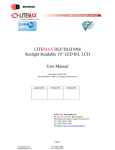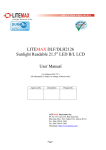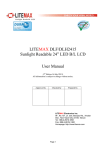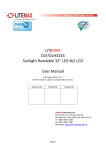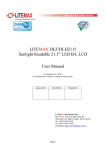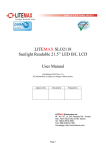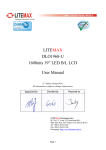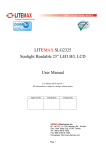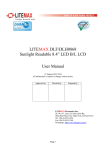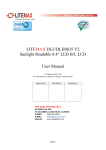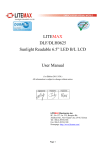Download LITEMAX DLF/DLH1236 V2 1000nits 12.1” LED B/L LCD User Manual
Transcript
LITEMAX DLF/DLH1236 V2 1000nits 12.1” LED B/L LCD User Manual (1st Edition 2013/6/28 ) All information is subject to change without notice. Approved by Checked by Prepared by LITEMAX Electronics Inc. 8F, No.137, Lane 235, Bau-chiau Rd., Shin-dian City, Taipei County, Taiwan R.O.C. Tel : 886-2-8919-1858 Fax: 886-2-8919-1300 Homepage: http://www.litemax.com.tw Page 1 RECORD OF REVISION Version and Date Jun,28,2013 Page Old Description All New Description Initial Release Page 2 Remark Contents RECORD OF REVISION........................................................................................................................ 2 Contents ................................................................................................................................................ 3 1.0 GENERAL DESCRIPTION .............................................................................................................. 4 1.1 FEATURES ............................................................................................................................... 4 1.2 GENERAL SPECIFICATIONS................................................................................................... 4 1.3 ABSOLUTE MAXIMUM RATINGS ............................................................................................ 5 2.0 Panel Specification ........................................................................................................................ 6 3.0 OPTICAL SPECIFICATION ........................................................................................................... 14 4.0 LED DRIVING BOARD SPECIFICATIONS ................................................................................... 16 5.0 AD6038GD SPECIFICATIONS (DLH1236 V2 only) ...................................................................... 19 6.0 MECHANICAL DRAWING ............................................................................................................. 33 7.0 PRECAUTIONS ............................................................................................................................. 35 Page 3 1.0 GENERAL DESCRIPTION DLF/DLH1236 V2 is 12.1” wide color TFT-LCD module as active switching devices with 1000nits LED backlight powered by Durapixel™ technology. This module has a 12.1 inch diagonally measured active area with XGA resolutions (1024 horizontal by 768 vertical pixel array). Each pixel is divided into RED, GREEN, BLUE dots which are arranged in vertical stripe and this module can display 16.2M colors. 1.1 FEATURES Brightness: 1000nits LED Backlight XGA(1024x768) High Shock & Vibration Resistance Low Power Consumption High Uniformity & Low EMI Noise Wide Temperature Life Expectancy 1.2 GENERAL SPECIFICATIONS Model No. Description Display Area (mm) Brightness Resolution Contrast Ratio Pixel Pitch (mm) Viewing Angle Display Colors Response Time (Typical) Power Consumption Dimensions (mm) Weight (Net) DLF1236 V2 DLH1236 V2 12.1” TFT LCD, LED Backlight ,1000nits,XGA(1024x768) 245.76(H) x 184.32(V)mm 1000 cd/m2 1024x768 (XGA) 700 : 1 0.24(H) x 0.24(V) +80°~‐80°(H), +70°~‐70°(V) 16.2M 16ms 9.6W 11.6W 396x324.0x14.5mm 0.55kg 0.6kg Page 4 1.3 ABSOLUTE MAXIMUM RATINGS Page 5 2.0 Panel Specification Page 6 Page 7 Page 8 Page 9 Page 10 Page 11 Page 12 Page 13 3.0 OPTICAL SPECIFICATION Item Symbol Data Unit Rx 0.6244 - Ry 0.3606 - Gx 0.3109 - 0.6211 - 0.1424 - 0.0851 - 0.2919 - Wy 0.3258 - Center Luminance of White Lc 1000 cd/㎡ Uniform Lu 80 % Contrast Ratio CR 700:1 - 68 % Red Color chromaticity Green Blue White Color Saturation Viewing Angle Gy Bx By Wx NTSC Horizontal Vertical Condition θx=0 θy=0 BM-7 θx=0 θy=0 Klein K-10 θx+ θxθy+ Note Test Mode:(1)(2)(3) Test Mode:(1)(4) 80 CR≧10 θy- 80 70 70 Test Mode: (1) Definition of Viewing Angle(θx,θy): Page 14 Deg Test Mode:(1)(3) (2) Definition of Test Point: A B C 1 2 3 Active Area (3)BM-7 Measurement Setup: (4)Klein K-10 Measurement Setup: Page 15 4.0 LED DRIVING BOARD SPECIFICATIONS 1. LED Application This specification is applied to LED converter unit for DLF/DLH1236 V2(1000 nits) LED backlight 2. Operating Characteristics Item Input Voltage Symbol Vin VIN=12V,Vadj=5V Input Current (Low Brightness) Input Current (High Brightness) LED Current (Low Brightness) LED Current (High Brightness) Working Frequency PWM Frequency Brightness Control ON/OFF Control Output Voltage Efficiency Conditions IinL MIN. TYP. MAX. 10.0 12.0 14.0 3 ----- ----- Unit V mA VIN=12V,Vadj=0V IinH 0.762 0.633 0.544 A VIN=12V,Vadj=5V IoutL 0.0 ----- ----- 0.3 0.3 0.3 VIN=12V,Vadj=0V IoutH Arms A Freq VIN=12V,Vadj=0V 900 1000 1100 KHz Freq VIN=12V 180 200 220 HZ 0.5 ----- 4.8 V 2 ----- 5 V Vadj Von/off Vout η Connection of Voltage Normal Operation VIN=12V,Vadj=0V VIN=12V,Vadj=0V Page 16 22.217 22.217 22.217 V 87.81 % 87.74 87.51 Remark 3. Connector Socket 3-1. Input Connector: J3(JST S 8B-PH-SM3-TB or Compatible) : PIN No Symbol 1 Vin DC+12V 2 Vin DC+12V 3 Vin DC+12V 4 GND Ground 5 GND Ground 6 GND Ground 7 8 Description Brightness Brightness Control Control ON/OFF Control 5V~0V 0.8V(OFF) 2~5V(ON) 3-2. Output Connector: J1,J2(JST S 2B-ZR-SM3A-TF or Compatible) : PIN NO Symbol Description 1 Output LED High Voltage( + ) 2 Output LED Low Voltage ( - ) Page 17 4. Mechanical Characteristics Dimension: 70mm*30mm*7mm INPUT CONNECTOR J3: PIN1:VIN PIN2:VIN PIN3:VIN PIN4:GND PIN5:GND PIN6GND PIN7:BRIGHTNESS PIN8:ON/OFF 7mm Page 18 5.0 AD6038GD SPECIFICATIONS (DLH1236 V2 only) Page 19 Page 20 Page 21 Page 22 Page 23 Page 24 J4, J3: Fan control (2PIN 2.0mm) Pin No. Function Pin No. Function 1 12V 2 GND J8: Key Pad (9PIN 2.0mm) Pin No. Function Pin No. Function 1 POWER KEY 6 MENU KEY 2 GREEN LED 7 AUTO KEY 3 RED LED 8 GND 4 DOWN KEY 9 GND 5 UP KEY JP1: Panel Power Pin No. Function Pin No. Function 1-2 12VDC 5-6 3.3V 3-4 5V CN6: RS232 Connector Pin No. Function Pin No. Function 1 5v 2 UART TX 3 UART RX 4 GND J9: Audio connector (3PIN 2.0mm) Pin No. Function Pin No. Function 1 GND 2 AUDIO-L 3 AUDIO-R J10: Speaker Connector (4PIN 2.0mm) Pin No. Function Pin No. Function 1 SPK_R+ 2 SPK_R- 3 SPK_L- 4 SPK_L+ J7: VR connector (3PIN 2.0mm) Pin No. Function Pin No. Function 1 3,3VDC 2 VR Out 3 GND Page 25 Page 26 OSD menu By pressing the “menu” button, you will see the below picture. Across from timing you will see resolution, frequency, and V-frequency of the panel. Version shows the firmware control version. These cannot be altered by the user. There are 7 sub menus within the OSD user interface: Brightness, Signal Select, Sound, Color, Image, Tools, and Exit. When you press the “menu” button, you enter the “Brightness” sub directory. In this directory, you will see 4 selections: press ’’right’’ key, you can go into the OSD Brightness. OSD Brightness: Press the “menu” once, to adjust the brightness. Press “left” to dim down the brightness to “0”, press “right” to increase the brightness to “100” Contrast: Press “menu” and “right” buttons to adjust the contrast from “0” to “100”. To adjust from “100” to “0”, press “menu” and the “left” buttons. Exit: back to the beginning menu. Page 27 Analog: RGB/VGA input Digital: DVI input DP: DisplayPort input Exit: back to the beginning menu. Auto Color:By navigating over to the “Auto Color” option, optimal color performance is invoked. SRGB: Windows standard color setting Page 28 Color Temperature: You have 4 options in this selection . Color Temperature User Define: Default is 100 for “R”, “G”, and “B”. Color Tempture_6500K: Warm color scheme Color Tempture_93OOK: Cold color scheme Exit: back to the beginning menu. Auto Adjust: Choose this option and the AD6038 will adjust to the optimal horizontal and vertical frequency. Clock: If you are not satisfied with the Auto tune result, you can adjust manually by pressing “Clock”. Using this will make the image wider. Page 29 Phase: If “double images” appear around the characters, choose “Phase” to remove them.. HPos: You can shift the screen horizontally using this function. Vpos: You can shift the screen vertically using this function. Exit: back to the beginning menu. OSD Control: Selecting this option, brings you to 5 more options: Page 30 Osd_time: Select time for the OSD user interface to stay on screen, for 2 sec. to 16 sec. Default is 6 sec. Osd_HPos: Moves the OSD user interface horizontally on screen. Osd_VPos: Moves the OSD user interface vertically on screen. Osd_Rotation: Rotates the OSD user interface Rotation(0°/90°/180°/270°) on screen. Exit: You can exit this sub menu back to the beginning Factory_Reset: By pressing this, the screen will revert to factory settings, and the previous settings will be deleted. Sharpness: Sharpen characters. Dos_mode/Gxf_mode: For some old programs which use 640x400 and 720x400 (DOS Mode and graphics mode), This option needs to be selected manually. Exit: back to the normal screen Page 31 OSD Lock Function: It is possible to lock all the OSD buttons to prevent unauthorized changes to occur by pressing “Left <” and “right >” and “Menu” buttons simultaneously. You will see the “lock” icon below on the center of the screen for 3 ~ 6 seconds. If any button is pushed after the lock function is initiated, the below icon will appear on the screen.' To release the OSD lock, press “Left <” and “right >” and “Menu”. The below icon will appear on the center of the screen for 3 ~ 6 seconds. Now all OSD keys are active again. Page 32 6.0 MECHANICAL DRAWING Page 33 Page 34 7.0 PRECAUTIONS HANDLING PRECAUTIONS (1) The module should be assembled into the system firmly by using every mounting hole. Be careful not to twist or bend the module. (2) While assembling or installing modules, it can only be in the clean area. The dust and oil may cause electrical short or damage the polarizer. (3) Use fingerstalls or soft gloves in order to keep display clean during the incoming inspection and assembly process. (4) Do not press or scratch the surface harder than a HB pencil lead on the panel because the polarizer is very soft and easily scratched. (5) If the surface of the polarizer is dirty, please clean it by some absorbent cotton or soft cloth. Do not use Ketone type materials (ex. Acetone), Ethyl alcohol, Toluene, Ethyl acid or Methyl chloride. It might permanently damage the polarizer due to chemical reaction. (6) Wipe off water droplets or oil immediately. Staining and discoloration may occur if they left on panel for a long time. (7) If the liquid crystal material leaks from the panel, it should be kept away from the eyes or mouth. In case of contacting with hands, legs or clothes, it must be washed away thoroughly with soap. (8) Protect the module from static electricity, it may cause damage to the C-MOS Gate Array IC. (9) Do not disassemble the module. (10) Do not pull or fold the lamp wire. (11) Pins of I/F connector should not be touched directly with bare hands. STORAGE PRECAUTIONS (1) High temperature or humidity may reduce the performance of module. Please store LCD module within the specified storage conditions. (2) It is dangerous that moisture come into or contacted the LCD module, because the moisture may damage LCD module when it is operating. (3) It may reduce the display quality if the ambient temperature is lower than 10 ºC. For example, the response time will become slowly, and the starting voltage of lamp will be higher than the room temperature. OPERATION PRECAUTIONS (1) Do not pull the I/F connector in or out while the module is operating. (2) Always follow the correct power on/off sequence when LCD module is connecting and operating. This can prevent the CMOS LSI chips from damage during latch-up. Page 35




































